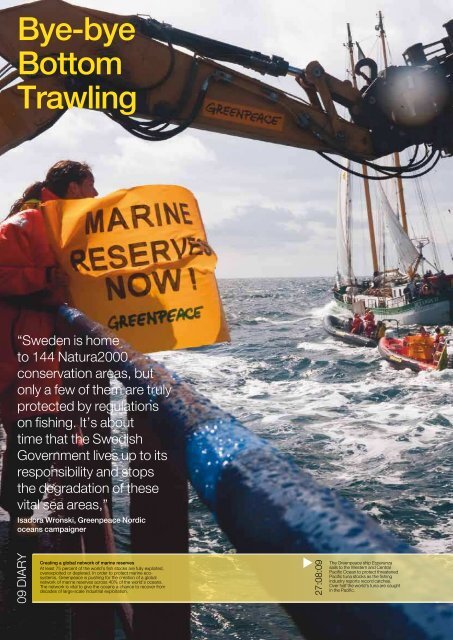Nordic - Greenpeace
Nordic - Greenpeace
Nordic - Greenpeace
Create successful ePaper yourself
Turn your PDF publications into a flip-book with our unique Google optimized e-Paper software.
Bye-bye<br />
Bottom<br />
Trawling<br />
“Sweden is home<br />
to 144 Natura2000<br />
conservation areas, but<br />
only a few of them are truly<br />
protected by regulations<br />
on fishing. It’s about<br />
time that the Swedish<br />
Government lives up to its<br />
responsibility and stops<br />
the degradation of these<br />
vital sea areas,”<br />
Isadora Wronski, <strong>Greenpeace</strong> <strong>Nordic</strong><br />
oceans campaigner<br />
August 2009. <strong>Greenpeace</strong> ships are<br />
heading out from Varberg on the west<br />
coast of Sweden, carrying 203 granite<br />
boulders and a determined mission<br />
to protect life underneath the surface<br />
20 kilometres from the shore in two<br />
extraordinary sea areas, Fladen and Lilla<br />
Middelgrund. By placing the boulders on<br />
the bottom of the ocean, fish and fauna<br />
will finally enjoy permanent rest from<br />
the massive and destructive bottom<br />
trawling taking place in spite of the fact<br />
that both areas were designated marine<br />
conservation areas, Natura2000, as long<br />
ago as 2003.<br />
Under EU rules and regulations, the<br />
Swedish Government is obligated to<br />
protect the designated areas via long<br />
term conservation planning, but after<br />
six years of inaction in regards to overexploitation,<br />
<strong>Greenpeace</strong>, with approval<br />
from the County Administrative Board in<br />
Halland, decided to do the job that the<br />
Swedish Government has neglected for<br />
so long.<br />
Boulder by boulder, metre by metre,<br />
a protective chain of solid granite<br />
was created on the seabed, making it<br />
impossible for bottom trawling vessels<br />
to slide their enormous nets through<br />
the important spawning and feeding<br />
grounds without catching a boulder<br />
instead of a cod.<br />
The effort to stop the destruction<br />
was supported by a wide range of<br />
people. Apart from the Swedish County<br />
Administrative Board, politicians from<br />
Denmark and Sweden welcomed the<br />
<strong>Greenpeace</strong> action and attacked the<br />
Swedish and Danish governments’<br />
lack of will to prioritise nature over<br />
the interests of the fishing industry.<br />
The head of the Swedish Board of<br />
Fisheries reacted by initiating a plan<br />
for how Sweden, a member of the EU,<br />
will handle ocean conservation.<br />
But there is no campaign without<br />
resistance – a resistance that ironically<br />
came from those who were hired to<br />
ensure that future generations can<br />
also enjoy the richness of Fladen and<br />
Lilla Middelgrund, namely the Swedish<br />
Environmental Protection Agency. The<br />
Agency decided to take <strong>Greenpeace</strong><br />
to court, but its complaints were<br />
overruled by the environmental judge<br />
in October 2009 on the grounds that<br />
the <strong>Greenpeace</strong> action was not illegal,<br />
and that the boulders now actually offer<br />
real protection to the conservation<br />
areas and the fish which depend on<br />
Fladen and Lilla Middelgrund for their<br />
livelihood – a judicial decision upheld<br />
by the Supreme Court on 5 March<br />
2010, and one that makes it very clear<br />
how one of the strongest critics of the<br />
<strong>Greenpeace</strong> action, Danish Minister<br />
of Food, Agriculture and Fisheries Eva<br />
Kjer Hansen, was wrong in attacking<br />
the action. The minister accused<br />
<strong>Greenpeace</strong> of acting as vigilantes,<br />
performing an illegal action and acting<br />
undemocratically. However, she<br />
declined to explain why the Danish<br />
Government itself had still not secured<br />
real protection for all of Denmark’s<br />
marine conservation areas, Natura2000,<br />
as required under EU rules.<br />
The placing of the boulders has created<br />
an oasis in Fladen and Lilla Middelgrund<br />
for valuable commercial fish stocks. This<br />
will have a significant spill-over effect<br />
on life in the Kattegat – an important<br />
victory in <strong>Greenpeace</strong>’s continued fight<br />
to protect life in the oceans.<br />
Image: Varberg/Lilla Middelgrund, Sweden<br />
<strong>Greenpeace</strong> places more than a hundred<br />
boulders to stop bottom trawling in<br />
the Natura 2000 sites Fladen and Lilla<br />
Middelgrund.<br />
©<strong>Greenpeace</strong>/Christian Åslund<br />
09 DIARY<br />
Creating a global network of marine reserves<br />
At least 75 percent of the world’s fish stocks are fully exploited,<br />
overexploited or depleted. In order to protect marine ecosystems,<br />
<strong>Greenpeace</strong> is pushing for the creation of a global<br />
network of marine reserves across 40% of the world’s oceans.<br />
The network is vital to give the oceans a chance to recover from<br />
decades of large-scale industrial exploitation.<br />
27:08:09<br />
The <strong>Greenpeace</strong> ship Esperanza<br />
sails to the Western and Central<br />
Pacific Ocean to protect threatened<br />
Pacific tuna stocks as the fishing<br />
industry reports record catches.<br />
Over half the world’s tuna are caught<br />
in the Pacific.<br />
20:10:09<br />
The Swedish environmental judge<br />
declares that <strong>Greenpeace</strong> was not<br />
doing anything illegal when it placed<br />
203 boulders in the vulnerable marine<br />
areas Fladen and Lilla Middelgrund<br />
in Sweden. In fact it is stated that the<br />
action is beneficial to the fish stocks.<br />
<strong>Greenpeace</strong> <strong>Nordic</strong> 2009 11

















